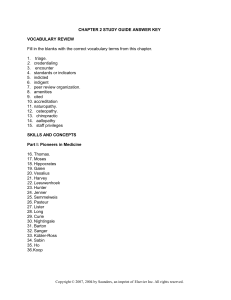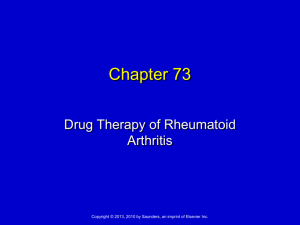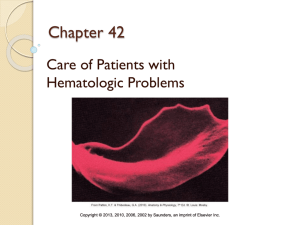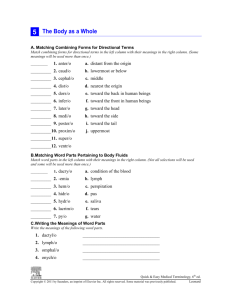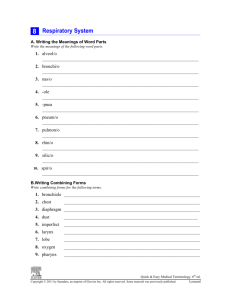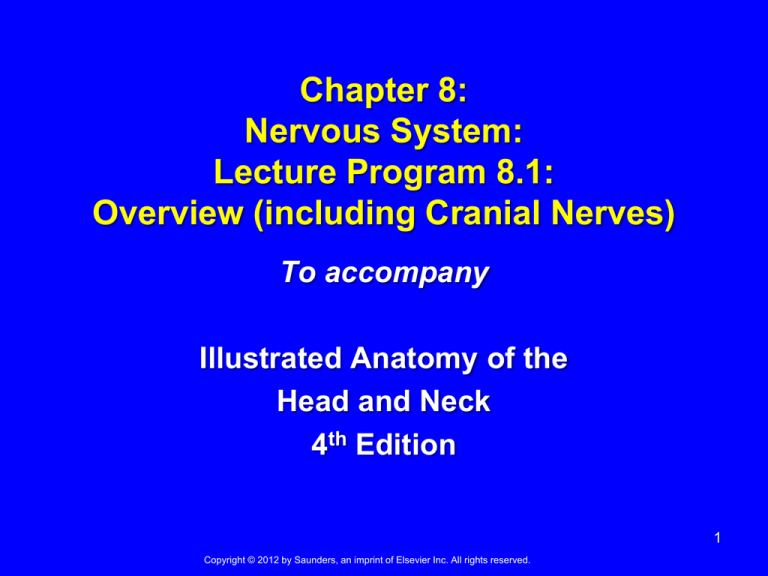
Chapter 8:
Nervous System:
Lecture Program 8.1:
Overview (including Cranial Nerves)
To accompany
Illustrated Anatomy of the
Head and Neck
4th Edition
1
Copyright © 2012 by Saunders, an imprint of Elsevier Inc. All rights reserved.
Lecture Program 8.1:
Outline
NERVOUS SYSTEM OVERVIEW
Central Nervous System
Peripheral Nervous System
Cranial Nerves
2
Copyright © 2012 by Saunders, an imprint of Elsevier Inc. All rights reserved.
Lecture Program 8.1:
Learning Objectives
1.
2.
3.
4.
5.
Define and pronounce all the key terms and
anatomic terms in this lecture.
Describe the components of the nervous
system and outline the actions of nerves.
Discuss the divisions of the central and
peripheral nervous systems.
Identify and trace the routes of the cranial
nerves on a diagram and skull.
Discuss the innervation of each of the
cranial nerves.
3
Copyright © 2012 by Saunders, an imprint of Elsevier Inc. All rights reserved.
Lecture Program 8.1:
Learning Objectives (continued)
8.
9.
10.
Discuss the nervous system pathology
associated with the head and neck region.
Correctly complete the review questions and
activities for this lecture.
Integrate an understanding of head and neck
nerves into clinical dental practice.
4
Copyright © 2012 by Saunders, an imprint of Elsevier Inc. All rights reserved.
Nervous System
Overview
5
Copyright © 2012 by Saunders, an imprint of Elsevier Inc. All rights reserved.
Nervous System Overview
The nervous system is an extensive,
intricate network of neural structures that
activates, coordinates, and controls all
functions of the body.
The nervous system causes muscles to
contract resulting in facial expressions and
even joint movements, such as those
involved in mastication and speech.
6
Copyright © 2012 by Saunders, an imprint of Elsevier Inc. All rights reserved.
Nervous System Overview
The system stimulates glands to secrete and
regulates many other systems of the body
such as the vascular system and digestive
system.
The nervous system also allows sensation to
be perceived, such as pain and touch during
dental treatment.
7
Copyright © 2012 by Saunders, an imprint of Elsevier Inc. All rights reserved.
Nervous System Overview
The nervous system has two main divisions:
central and peripheral.
Figure 8-1
8
Copyright © 2012 by Saunders, an imprint of Elsevier Inc. All rights reserved.
Nervous System Overview
Figure 8-2
9
Copyright © 2012 by Saunders, an imprint of Elsevier Inc. All rights reserved.
Case Study 8.0
Age
84 yrs
Scenario
Sex
Female
Height
5’ 4”
Weight
275 lbs
Chief
Complaint
“What can I do to
keep my mouth
healthy?”
Medical
History
Recent history of a
cerebrovascular
accident - her speech
is not affected but her
right side has
physical limitations,
especially in the oral
region
Blood pressure now
controlled by
medication; working
on obesity
A patient of
record is
concerned
about her oral
health. A full
examination
was
performed and
a clinical
photograph
was taken as
well as a full
mouth
radiographic
series.
Current
Medications
Social
History
Antidepressant
Anticoagulant
Antihypertensives
Retired high school
teacher
She is
overdue for
her
maintenance
appointment
and needs a
periodontal
evaluation.
10
Copyright © 2012 by Saunders, an imprint of Elsevier Inc. All rights reserved.
Nervous System Overview
The neuron is the
cellular component of
the nervous system and
is composed of a cell
body and neural
processes.
A nerve is a bundle of
neural processes
outside the central
nervous system and in
the peripheral nervous
system.
Figure 8-1
11
Copyright © 2012 by Saunders, an imprint of Elsevier Inc. All rights reserved.
Nervous System Overview
A synapse is the
junction between
two neurons or
between a neuron
and an effector
organ, where neural
impulses are
transmitted.
Figure 8-1
12
Copyright © 2012 by Saunders, an imprint of Elsevier Inc. All rights reserved.
Nervous System Overview
In order to function, most tissue, structures,
and organs have innervation, a supply of
nerves to the body part.
A nerve allows information to be carried to
and from the brain, which is the central
information center.
13
Copyright © 2012 by Saunders, an imprint of Elsevier Inc. All rights reserved.
Nervous System Overview
An accumulation of
neuron cell bodies
outside the central
nervous system is a
ganglion (plural,
ganglia) such as
the trigmeninal
ganglion.
Figure 8-8
14
Copyright © 2012 by Saunders, an imprint of Elsevier Inc. All rights reserved.
Nervous System Overview:
Afferent and Efferent Nerves
Nerves are of two
types: afferent and
efferent.
Figure 8-1
15
Copyright © 2012 by Saunders, an imprint of Elsevier Inc. All rights reserved.
Nervous System Overview:
Afferent and Efferent Nerves
An afferent nerve or sensory nerve carries
information from the periphery of the body to
the brain (or spinal cord).
Thus an afferent nerve carries sensory
information such as taste, pain, and
proprioception to the brain.
16
Copyright © 2012 by Saunders, an imprint of Elsevier Inc. All rights reserved.
Nervous System Overview:
Afferent and Efferent Nerves
An efferent nerve or motor nerve carries
information away from the brain (or spinal
cord) to the periphery of the body.
Thus an efferent nerve carries information to
the muscles in order to activate them, often in
response to information received by way of
the afferent nerves.
17
Copyright © 2012 by Saunders, an imprint of Elsevier Inc. All rights reserved.
Nervous System Overview:
Afferent and Efferent Nerves
Figure 8-1
18
Copyright © 2012 by Saunders, an imprint of Elsevier Inc. All rights reserved.
Nervous System Overview
The plasma membrane of a neuron, like all
other cells, has an unequal distribution of ions
and electric charges between the two sides of
the membrane.
The fluid outside of the membrane has a
positive charge; the fluid inside has a
negative charge.
This charge difference is a resting potential
and is measured in millivolts.
19
Copyright © 2012 by Saunders, an imprint of Elsevier Inc. All rights reserved.
Nervous System Overview
The rapid depolarization
of the cell membrane
results in an action
potential, which then
causes propagation of the
nerve impulse along the
membrane.
An action potential is a
temporary reversal of the
electric potential along the
membrane for a brief
period (less than a
millisecond).
Figure 8-1
20
Copyright © 2012 by Saunders, an imprint of Elsevier Inc. All rights reserved.
Nervous System Overview
The action potential begins at one spot on the
membrane but spreads to adjacent areas of
the membrane, propagating the impulse
along the length of the cell membrane.
After passage of the action potential, there is
a brief period—the refractory period—during
which the membrane cannot be stimulated.
21
Copyright © 2012 by Saunders, an imprint of Elsevier Inc. All rights reserved.
Nervous System Overview
To have the impulse
cross the synapse to
another cell requires
the actions of
chemical agents or
neurotransmitters
from the neuron,
which are discharged
with the arrival of the
action potential.
Figure 8-1
22
Copyright © 2012 by Saunders, an imprint of Elsevier Inc. All rights reserved.
Central Nervous System:
Synapse and Neurotransmitters
Applegate EJ. The Anatomy and Physiology Learning System, ed 3. Elsevier, 2006
Copyright © 2012 by Saunders, an imprint of Elsevier Inc. All rights reserved.
23
Clinical Note:
Anesthesia
Many local anesthetic agents such as
lidocaine, as used in dentistry, mimic
inhibitory neurotransmitters by decreasing
sensory neurons’ ability to generate an action
potential, thus producing localized
anesthesia.
Anesthesia is the loss of feeling or sensation
resulting from the use of certain drugs or
gases that serve as inhibitory
neurotransmitters.
24
Copyright © 2012 by Saunders, an imprint of Elsevier Inc. All rights reserved.
Nervous System
Central Nervous System
25
Copyright © 2012 by Saunders, an imprint of Elsevier Inc. All rights reserved.
Central Nervous System
One of the major
divisions of the
nervous system, the
central nervous
system (CNS)
includes both the
brain and spinal
cord.
Figure 8-1
26
Copyright © 2012 by Saunders, an imprint of Elsevier Inc. All rights reserved.
Central Nervous System
One of the major divisions of the nervous system, the central
nervous system (CNS) includes both the brain and spinal cord.
Figure 8-2
27
Copyright © 2012 by Saunders, an imprint of Elsevier Inc. All rights reserved.
Central Nervous System
The system of
membranes is the
meninges, which
has three layers:
dura mater,
arachnoid mater,
and pia mater.
Figure 8-4C
28
Copyright © 2012 by Saunders, an imprint of Elsevier Inc. All rights reserved.
Central Nervous System
The dura mater also
surrounds and
supports the large
venous channels
(dural sinuses)
carrying blood from
the brain toward the
heart such as the
cavernous sinus in
the head.
Figure 6-12
Copyright © 2012 by Saunders, an imprint of Elsevier Inc. All rights reserved.
29
Central Nervous System
Applegate EJ. The Anatomy and Physiology Learning System, ed 3. Elsevier, 2006
Copyright © 2012 by Saunders, an imprint of Elsevier Inc. All rights reserved.
30
Central Nervous System
Figure
8-4C
31
Copyright © 2012 by Saunders, an imprint of Elsevier Inc. All rights reserved.
Central Nervous System: Brain
The major divisions
of the brain include:
the cerebrum, the
cerebellum, the
brainstem, and the
diencephalon.
Figure 8-3
Copyright © 2012 by Saunders, an imprint of Elsevier Inc. All rights reserved.
32
Central Nervous System: Brain
The cerebrum is
the largest division
of the brain and
consists of two
cerebral
hemispheres.
The cerebellum is
the second largest
division of the brain,
after the cerebrum.
Figure 8-3
Copyright © 2012 by Saunders, an imprint of Elsevier Inc. All rights reserved.
33
Central Nervous System: Brain
The brainstem has
a number of
divisions including
the medulla, pons,
and midbrain.
Figure 8-4A
34
Copyright © 2012 by Saunders, an imprint of Elsevier Inc. All rights reserved.
Central Nervous System: Brain
The medulla is closest
to the spinal cord.
The pons connects the
medulla with the
cerebellum and with
higher brain centers.
The midbrain includes
relay stations for
hearing, vision, and
motor pathways.
Figure 8-4A
35
Copyright © 2012 by Saunders, an imprint of Elsevier Inc. All rights reserved.
Central Nervous System: Brain
Superior to the
brainstem, the
diencephalon primarily
includes the thalamus
and hypothalamus.
The thalamus serves
as a central relay point
for incoming nerve
impulses.
The hypothalamus
regulates homeostasis.
Figure 8-4A
36
Copyright © 2012 by Saunders, an imprint of Elsevier Inc. All rights reserved.
Central Nervous System:
Spinal Cord
The other
component of the
CNS, the spinal
cord, runs along the
dorsal side of the
body and links the
brain to the rest of
the body.
Figure 8-4A
37
Copyright © 2012 by Saunders, an imprint of Elsevier Inc. All rights reserved.
Dissection
Brain and Spinal Cord
Figure 8-4B
38
Copyright © 2012 by Saunders, an imprint of Elsevier Inc. All rights reserved.
Imaging
Brain and Spinal Cord
Figure 8-4B
Figure 8-4D: MRI
39
Copyright © 2012 by Saunders, an imprint of Elsevier Inc. All rights reserved.
Nervous System
Peripheral Nervous System
40
Copyright © 2012 by Saunders, an imprint of Elsevier Inc. All rights reserved.
Peripheral Nervous System
The other major
division of the
nervous system, the
peripheral nervous
system (PNS), is
composed of all the
nerves stretching their
pathways among the
CNS and the
receptors, muscles,
and glands.
Figure 8-1
41
Copyright © 2012 by Saunders, an imprint of Elsevier Inc. All rights reserved.
Peripheral Nervous System
The other major division of the nervous system, the peripheral nervous
system (PNS), is composed of all the nerves stretching their pathways
among the CNS and receptors, muscles, and glands.
Figure 8-2
42
Copyright © 2012 by Saunders, an imprint of Elsevier Inc. All rights reserved.
Peripheral Nervous System
The PNS is further divided into the afferent
nervous system or sensory nervous
system, which carries information from
receptors to the brain or spinal cord, and the
efferent nervous system or motor nervous
system, which carries information from the
brain or spinal cord to muscles or glands.
43
Copyright © 2012 by Saunders, an imprint of Elsevier Inc. All rights reserved.
Peripheral Nervous System
A nerve cell leading
from the eye to the
brain and carrying
visual information is a
part of the afferent
nervous system.
A nerve cell leading
from the brain to the
muscles controlling the
eye’s movement is a
part of the efferent
nervous system.
Figure 8-1
44
Copyright © 2012 by Saunders, an imprint of Elsevier Inc. All rights reserved.
Peripheral Nervous System:
Somatic and Autonomic
The efferent division of the PNS is further subdivided into the
somatic nervous system and the autonomic nervous system.
Figure 8-2
45
Copyright © 2012 by Saunders, an imprint of Elsevier Inc. All rights reserved.
Peripheral Nervous System:
Somatic and Autonomic
The somatic nervous system (SNS) is a
subdivision of the efferent division of the
peripheral nervous system and includes all
nerves controlling the muscular system and
external sensory receptors.
The SNS involves both receptors and
effectors.
46
Copyright © 2012 by Saunders, an imprint of Elsevier Inc. All rights reserved.
Peripheral Nervous System:
Somatic and Autonomic
The autonomic nervous system (ANS) is
the other subdivision of the efferent division
of the peripheral nervous system.
This system operates without any conscious
control as the caretaker of the body.
Autonomic fibers are efferent nerves, and
they always occur in two-nerve chains: the
first nerve carries autonomic fibers to a
ganglion, where they terminate near the cell
bodies of the second nerve.
47
Copyright © 2012 by Saunders, an imprint of Elsevier Inc. All rights reserved.
Autonomic Nervous System:
Sympathetic and Parasympathetic
The ANS itself has two nervous system subdivisions:
sympathetic and parasympathetic.
Figure 8-2
48
Copyright © 2012 by Saunders, an imprint of Elsevier Inc. All rights reserved.
Autonomic Nervous System:
Sympathetic and Parasympathetic
The sympathetic nervous system is
involved in “fight-or-flight responses” such as
the shutdown of salivary gland secretion with
certain medications.
The parasympathetic nervous system is
involved in “rest-or-digest” responses such as
the stimulation of salivary gland secretions.
49
Copyright © 2012 by Saunders, an imprint of Elsevier Inc. All rights reserved.
Parasympathetic Nervous System
Parasympathetic fibers associated with the
glands of the head and neck region are carried
within various cranial nerves and are briefly
described here, as well as in greater detail later.
Their ganglia are located in the head, and
therefore parasympathetic neurons in this region
may be either preganglionic neurons (before
relaying in the ganglion) or postganglionic
neurons (after relaying in the ganglion).
50
Copyright © 2012 by Saunders, an imprint of Elsevier Inc. All rights reserved.
Nervous System
Applegate EJ. The Anatomy and Physiology Learning System, ed 3. Elsevier, 2006
Copyright © 2012 by Saunders, an imprint of Elsevier Inc. All rights reserved.
51
Brain Review - Ventral View
Fehrenbach MJ, editor, Dental Anatomy Coloring Book, WB Saunders, Philadelphia, 2007
Copyright © 2012 by Saunders, an imprint of Elsevier Inc. All rights reserved.
52
Brain Review - Ventral View
Fehrenbach MJ, editor, Dental Anatomy Coloring Book, WB Saunders, Philadelphia, 2007
Copyright © 2012 by Saunders, an imprint of Elsevier Inc. All rights reserved.
53
Brain and Spinal Cord ReviewLateral Sagittal View
Fehrenbach MJ, editor, Dental Anatomy Coloring Book, WB Saunders, Philadelphia, 2007
Copyright © 2012 by Saunders, an imprint of Elsevier Inc. All rights reserved.
54
Brain and Spinal Cord ReviewLateral Sagittal View
Fehrenbach MJ, editor, Dental Anatomy Coloring Book, WB Saunders, Philadelphia, 2007
Copyright © 2012 by Saunders, an imprint of Elsevier Inc. All rights reserved.
55
Brain and Spinal Cord Review
ID 1
Copyright © 2012 by Saunders, an imprint of Elsevier Inc. All rights reserved.
56
Nervous System
Cranial Nerves
57
Copyright © 2012 by Saunders, an imprint of Elsevier Inc. All rights reserved.
Cranial Nerves
The cranial nerves are an important part of the PNS.
All 12 paired cranial nerves are connected to the brain at its base
and pass through the skull by way of fissures or foramina.
Figure 8-5
58
Copyright © 2012 by Saunders, an imprint of Elsevier Inc. All rights reserved.
Cranial Nerves
The cranial nerves are an important part of the PNS. All 12 paired
cranial nerves are connected to the brain at its base and pass
through the skull by way of fissures or foramina.
Figure 8-6
Copyright © 2012 by Saunders, an imprint of Elsevier Inc. All rights reserved.
59
Cranial Nerves
Some cranial nerves are either afferent or
efferent, and others have both types of neural
processes.
Both Roman numerals (I to XII) and anatomic
terms are used to designate the cranial
nerves.
60
Copyright © 2012 by Saunders, an imprint of Elsevier Inc. All rights reserved.
61
Copyright © 2012 by Saunders, an imprint of Elsevier Inc. All rights reserved.
CRANIAL NERVE I
The first (I) cranial or
olfactory nerve transmits
smell from the nasal mucosa
to the brain and thus
functions as an afferent
nerve.
The nerve enters the skull
through the perforations in
the cribriform plate of the
ethmoid bone to join the
olfactory bulb in the brain.
Bath-Balogh M and
Fehrenbach MJ.
Illustrated Dental
Embryology,
Histology, Anatomy,
ed 3. Saunders,
Philadelphia, 2011.
Figure 8-6
62
Copyright © 2012 by Saunders, an imprint of Elsevier Inc. All rights reserved.
Dissection
CRANIAL NERVE I
Figure 9-24
Copyright © 2012 by Saunders, an imprint of Elsevier Inc. All rights reserved.
63
CRANIAL NERVE II
The second (II) cranial
or optic nerve
transmits sight from the
retina of the eye to the
brain and thus functions
as an afferent nerve.
From Applegate EJ: The
anatomy and physiology
learning system, ed 3, St.
Louis, Saunders 2006.
Figure 8-6
64
Copyright © 2012 by Saunders, an imprint of Elsevier Inc. All rights reserved.
CRANIAL NERVE II
The optic nerve
enters the skull
through the optic
canal of the
sphenoid bone on
its way from the
retina.
Figure 3-19
Copyright © 2012 by Saunders, an imprint of Elsevier Inc. All rights reserved.
65
CRANIAL NERVE III
The third (III) cranial
or oculomotor
nerve serves as an
efferent nerve to
some of the eye
muscles that move
the eyeball.
Figure 8-6
66
Copyright © 2012 by Saunders, an imprint of Elsevier Inc. All rights reserved.
CRANIAL NERVE III
The oculomotor
nerve lies in the
lateral wall of the
cavernous sinus and
exits the skull
through the superior
orbital fissure of the
sphenoid bone on
its way to the orbit.
Figure 3-19
Copyright © 2012 by Saunders, an imprint of Elsevier Inc. All rights reserved.
67
CRANIAL NERVE IV
The small fourth (IV)
cranial or trochlear
nerve also serves as
an efferent nerve for
one eye muscle, as
well as
proprioception, similar
to the oculomotor
nerve but without any
parasympathetic
fibers.
Figure 8-6
68
Copyright © 2012 by Saunders, an imprint of Elsevier Inc. All rights reserved.
CRANIAL NERVE IV
Similar to the
oculomotor nerve, the
trochlear nerve runs
in the lateral wall of
the cavernous sinus
and exits the skull
through the superior
orbital fissure of the
sphenoid bone on its
way to the orbit.
Figure 3-19
Copyright © 2012 by Saunders, an imprint of Elsevier Inc. All rights reserved.
69
CRANIAL NERVE V
The fifth (V) cranial or
trigeminal nerve has
both an efferent
component for the
muscles of mastication,
as well as some other
cranial muscles, and an
afferent component for
the teeth, tongue, and
oral cavity, as well as
most of the skin of the
face and head.
Figure 8-6
70
Copyright © 2012 by Saunders, an imprint of Elsevier Inc. All rights reserved.
Dissection
CRANIAL NERVE V
The sensory root of the trigeminal nerve has three
nerve divisions: ophthalmic, maxillary, and mandibular.
Figures 8-7A, B
71
Copyright © 2012 by Saunders, an imprint of Elsevier Inc. All rights reserved.
CRANIAL NERVE V
The ophthalmic nerve
(division) provides
sensation to the upper
face and scalp.
The maxillary and
mandibular nerves
(divisions) provide
sensation to the
middle and lower
face, respectively.
Figure 8-8
72
Copyright © 2012 by Saunders, an imprint of Elsevier Inc. All rights reserved.
Dissection
CRANIAL NERVE V
Each of the three
nerves or divisions
of the sensory root
of the trigeminal
nerve enters the
skull in one of three
different locations in
the sphenoid bone.
Figure 8-7B
73
Copyright © 2012 by Saunders, an imprint of Elsevier Inc. All rights reserved.
CRANIAL NERVE V
The ophthalmic nerve
or division enters
through the superior
orbital fissure.
The maxillary nerve or
division enters by way
of the foramen
rotundum.
The mandibular nerve
or division passes
through the skull by way
of the foramen ovale.
Figure 8-6
74
Copyright © 2012 by Saunders, an imprint of Elsevier Inc. All rights reserved.
CRANIAL NERVE V
The motor root of
the trigeminal
nerve accompanies
the mandibular
nerve of the sensory
root and also exits
the skull through the
foramen ovale of the
sphenoid bone.
Figure 8-6
75
Copyright © 2012 by Saunders, an imprint of Elsevier Inc. All rights reserved.
CRANIAL NERVE V
The trigeminal nerve
is the most
important cranial
nerve to the dental
professional
because it
innervates relevant
tissue, structures,
and organs of the
head and neck.
Figure 8-8
76
Copyright © 2012 by Saunders, an imprint of Elsevier Inc. All rights reserved.
CRANIAL NERVE VI
The sixth (VI) cranial
or abducens nerve
or abducent nerve
serves as an
efferent nerve to
one of the muscles
that moves the
eyeball, similar to
the oculomotor and
trochlear nerves.
Figure 8-6
77
Copyright © 2012 by Saunders, an imprint of Elsevier Inc. All rights reserved.
CRANIAL NERVE VI
Similar to both of
those cranial
nerves, the
abducens nerve
exits the skull
through the superior
orbital fissure of the
sphenoid bone on
its way to the orbit.
Figure 3-19
Copyright © 2012 by Saunders, an imprint of Elsevier Inc. All rights reserved.
78
CRANIAL NERVE VII
The seventh (VII) cranial or facial nerve carries both
efferent and afferent components.
The nerve carries an efferent component for the muscles
of facial expression and for the preganglionic
parasympathetic innervation of the lacrimal gland (relaying
in the pterygopalatine ganglion) as well as the
submandibular and sublingual salivary glands (relaying in
the submandibular ganglion).
Figure 8-20
Applegate EJ. The Anatomy and Physiology Learning System, ed 3. Elsevier, 2006
Drake RL, et al. Gray’s Anatomy for Students, ed 2, Churchill Livingson, 2010
Copyright © 2012 by Saunders, an imprint of Elsevier Inc. All rights reserved.
79
CRANIAL NERVE VII
Figure 8-21
Figure 8-22
80
Copyright © 2012 by Saunders, an imprint of Elsevier Inc. All rights reserved.
CRANIAL NERVE VII
The facial nerve
leaves the cranial
cavity by passing
through the internal
acoustic meatus,
which leads to the
facial canal inside
the temporal bone.
Figure 8-6
81
Copyright © 2012 by Saunders, an imprint of Elsevier Inc. All rights reserved.
CRANIAL NERVE VII
Finally, the facial nerve
exits the skull by way of
the stylomastoid foramen
of the temporal bone.
This nerve is also
important to dental
professionals because it
innervates relevant
tissue of the head and
neck and travels through
the parotid gland.
Figure 3-18
Copyright © 2012 by Saunders, an imprint of Elsevier Inc. All rights reserved.
82
CRANIAL NERVE VIII
The eighth (VIII)
cranial or
vestibulocochlear
nerve serves as an
afferent nerve for
hearing and balance.
This nerve conveys
signals from the inner
ear to the brain.
Figure 8-6
83
Copyright © 2012 by Saunders, an imprint of Elsevier Inc. All rights reserved.
CRANIAL NERVE VIII
The nerve enters
the cranial cavity
through the internal
acoustic meatus of
the temporal bone.
Figure 3-19
Copyright © 2012 by Saunders, an imprint of Elsevier Inc. All rights reserved.
84
CRANIAL NERVE IX
The ninth (IX) cranial or glossopharyngeal nerve
carries an efferent component for the pharyngeal
muscle, the stylopharyngeus muscle, and the
preganglionic gland parasympathetic innervation for
the parotid salivary gland (relaying the otic ganglion).
The nerve also carries an afferent component for the
oropharynx and for taste and general sensation from
the base of the tongue, and thus is the afferent limb
of the gag reflex.
Figure 7-2
Figure 2-17
Copyright © 2012 by Saunders, an imprint of Elsevier Inc. All rights reserved.
85
CRANIAL NERVE IX
The
glossopharyngeal
nerve passes
through the skull by
way of the jugular
foramen, between
the occipital and
temporal bones.
Figure 3-19
Copyright © 2012 by Saunders, an imprint of Elsevier Inc. All rights reserved.
86
CRANIAL NERVE IX
After supplying the
ear,
parasympathetic
fibers leave the skull
through the foramen
ovale of the
sphenoid bone as
the lesser petrosal
nerve.
Figure 3-32
Copyright © 2012 by Saunders, an imprint of Elsevier Inc. All rights reserved.
87
CRANIAL NERVE IX
These preganglionic
fibers (parasympathetic
fibers) then terminate in
the otic ganglion.
The otic ganglion is
located near the medial
surface of the
mandibular nerve of the
trigeminal or fifth cranial
nerve, just inferior to the
foramen ovale.
Figure 8-20
88
Copyright © 2012 by Saunders, an imprint of Elsevier Inc. All rights reserved.
CRANIAL NERVE X
The tenth (X) cranial or vagus nerve carries a large
efferent component for the muscles of the soft palate,
pharynx, and larynx and for parasympathetic fibers to
many organs in the thorax and abdomen including
the thymus gland, heart, and stomach.
The nerve carries a smaller afferent component for a
small amount of skin around the ear and for taste
sensation for the epiglottis.
89
Copyright © 2012 by Saunders, an imprint of Elsevier Inc. All rights reserved.
CRANIAL NERVE X
The vagus nerve
passes through the
skull by way of the
jugular foramen,
between the occipital
and temporal bones.
This nerve is important
to dental professionals
because it innervates
relevant tissue of the
head and neck.
Figure 3-19
Copyright © 2012 by Saunders, an imprint of Elsevier Inc. All rights reserved.
90
CRANIAL NERVE XI
The eleventh (XI)
cranial or accessory
nerve functions as an
efferent nerve for the
trapezius and
sternocleidomastoid
muscles as well as for
muscles of the soft
palate and pharynx.
Figure
2-23
Figure
2-21
91
Copyright © 2012 by Saunders, an imprint of Elsevier Inc. All rights reserved.
CRANIAL NERVE XI
The accessory nerve
exits the skull through
the jugular foramen,
between the occipital
and temporal bones.
This nerve is
important to dental
professionals
because it innervates
relevant tissue of the
head and neck.
Figure 8-6
92
Copyright © 2012 by Saunders, an imprint of Elsevier Inc. All rights reserved.
CRANIAL NERVE XII
The twelfth (XII) cranial or
hypoglossal nerve
functions as an efferent
nerve for both the intrinsic
and extrinsic muscles of the
tongue.
The nerve exits the skull
through the hypoglossal
canal in the occipital bone.
The hypoglossal nerve is
important to dental
professionals because it
innervates the tongue.
Figure 3-19
Copyright © 2012 by Saunders, an imprint of Elsevier Inc. All rights reserved.
93
Parasympathetic Nervous System
and Cranial Nerves
Drake RL, et al. Gray’s Anatomy for Students, ed 2, Churchill Livingson, 2010
Copyright © 2012 by Saunders, an imprint of Elsevier Inc. All rights reserved.
94
Brain and
Cranial
Nerves
ReviewVentral
Surface
Showing
Nerve
Attachment
Fehrenbach MJ, editor, Dental Anatomy Coloring Book, WB Saunders, Philadelphia, 2007
Copyright © 2012 by Saunders, an imprint of Elsevier Inc. All rights reserved.
95
Brain and
Cranial
Nerves
ReviewVentral
Surface
Showing
Nerve
Attachment
Fehrenbach MJ, editor, Dental Anatomy Coloring Book, WB Saunders, Philadelphia, 2007
Copyright © 2012 by Saunders, an imprint of Elsevier Inc. All rights reserved.
96
Cranial Nerves and Skull ReviewInternal View of Skull Base
Fehrenbach MJ, editor, Dental Anatomy Coloring Book, WB Saunders, Philadelphia, 2007
Copyright © 2012 by Saunders, an imprint of Elsevier Inc. All rights reserved.
97
Cranial Nerves and Skull ReviewInternal View of Skull Base
Fehrenbach MJ, editor, Dental Anatomy Coloring Book, WB Saunders, Philadelphia, 2007
Copyright © 2012 by Saunders, an imprint of Elsevier Inc. All rights reserved.
98
Cranial Nerve Supply to Oral
Cavity Review
Fehrenbach MJ, editor, Dental Anatomy Coloring Book, WB Saunders, Philadelphia, 2007
Copyright © 2012 by Saunders, an imprint of Elsevier Inc. All rights reserved.
99
Cranial Nerve Supply to Oral
Cavity Review
Fehrenbach MJ, editor, Dental Anatomy Coloring Book, WB Saunders, Philadelphia, 2007
Copyright © 2012 by Saunders, an imprint of Elsevier Inc. All rights reserved.
100
Cranial Nerve Review
ID 2
Copyright © 2012 by Saunders, an imprint of Elsevier Inc. All rights reserved.
101
Cranial Nerve Review
ID 3
Copyright © 2012 by Saunders, an imprint of Elsevier Inc. All rights reserved.
102
Nervous System
Table Summary
103
Copyright © 2012 by Saunders, an imprint of Elsevier Inc. All rights reserved.
104
Copyright © 2012 by Saunders, an imprint of Elsevier Inc. All rights reserved.





